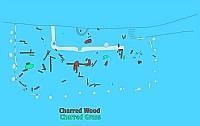
Plan of Hank's house showing location of
charred wood and grass on and just above the floor. Graphic
by Sandy Hannum, courtesy Prewitt and Associates, Inc.
Click on image to open
|
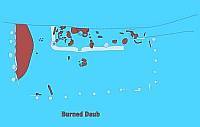
Plan of Hank's house showing location of fired
daub on and just above the floor. Graphic by Sandy Hannum,
courtesy Prewitt and Associates, Inc.
|
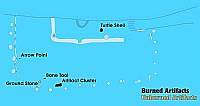
Plan of Hank's house showing location of
artifacts resting on the floor. Graphic by Sandy Hannum, courtesy
Prewitt and Associates, Inc.
|
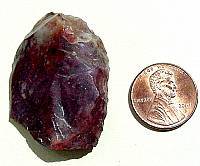
A
small scraper made of the distinctive red-and-white banded Alibates
agate was found near the back wall of Hank’s house. It
also was slightly discolored and fractured due to heating, having
been inside the house when it burned. This scraper was probably
once hafted, or tied onto a handle, but its base end and working
edge are broken. Photo by Doug Boyd. |
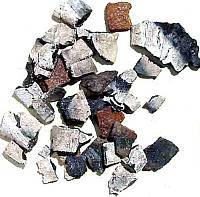
In
the depressed channel on the floor of Hank's house, right around
the central fire hearth, numerous tiny bones and flint flakes
were found lying on the floor. This photo shows a group of turtle
shell fragments and tiny flakes that were all clustered in one
area and had apparently been trampled into the floor. They were
so intensively burned that it suggests they were heated in the
fire hearth rather than when the house burned down. Photo by
Doug Boyd. |

Close
up of some of the intensively burned turtle shell fragments.
When bones are first heated in a fire, they turn black.
If the heating continues, they eventually turn white. Photo
by Doug Boyd.
|
|
Why did Hank's house burn? Burned houses are common
in many prehistoric sites of many different cultures, and they are
very common among some Southwestern and Plains groups. There are
many different reasons why a house might burn, such as:
Accidental burning by natural causes—a
wildfire spreads and sets a house on fire;
Accidental burning by people—a spark from
the fireplace ignites the roof, or an outdoor cooking fire gets
out of hand;
Intentional burning by inhabitants—an
abandoned lodge becomes old and dangerous and is intentionally torched;
Intentional ritual burning by inhabitants—the
lodge is burned as part of a mortuary ritual when someone who lived
in the house died;
Intentional burning by others—enemies
attack the village and set fire to the houses.
Archeologists have seen evidence of all of these
causes at different sites in the Southwest and Great Plains, and
there are often clues as to why a house burned. An attack by an
enemy group, for example, may be a likely explanation for burned
houses if bodies are found within the house or if there is good
evidence that violence played a role at that particular time and
place. In other cases, archeologists have speculated about the cause
of house burning based on the artifacts found inside. A house full
of useful tools and complete pots could have been burned accidentally
with peoples' possessions left in them. Alternatively, some houses
are relatively clean, with few or no artifacts found in them. Such
houses appear to have been abandoned before being burned.
The Upper Republican culture in southern Nebraska
is one example where houses may have been burned intentionally on
a regular basis. Like the Plains villagers who lived in the Texas
Panhandle, these people were buffalo-hunting farmers who built earth
lodges. This culture is contemporaneous with some of the Plains
Village period in the Texas Panhandle, and some of their houses
were similar to Hank's house in layout, but they were usually a
little larger. The frequency of burned lodges in some of the Upper
Republican sites is so high that archeologist Donna Roper of Kansas
State University suggests that these people were deliberately burning
old and dilapidated houses.
It seems likely that Hank's house is another case
of burning an abandoned house, and the burning may have been intentional.
Several lines of evidence come into play for interpreting this.
First, if the house burned accidentally, then many of the peoples'
belongings might have been left inside and burned with the house.
There were few artifacts found directly on the house floor, and
most were unusable flakes or potsherds that were trampled into the
floor. The small cache of tools found along the south wall represents
relatively unimportant, or at least easily replaceable, items.
If Hank's house was burned intentionally after it
was abandoned, another important question comes to mind. How
long was the house used? Archeologists and anthropologists have
spent lots of time studying the "longevity" of various
types of houses among cultures around the world. They are always
interested in knowing how long a particular kind of house will last
and remain habitable after it is built. The biggest factors in determining
the longevity of simple houses are: (1) the location and setting
of the house; (2) the type of foundation used; (3) the nature of
the soil/substrate; and (4) the materials used in constructing the
walls and roof. Both pithouses and earth lodges required regular
maintenance to keep them in tip-top shape, and a well-maintained
house would certainly have lasted longer than one that was neglected.
At Hank's house, all of the juniper roof support and wall posts
were set directly into the ground and would have been subjected
to slow deterioration due to wetting/drying and insects. If Hank's
house were an earth lodge with a heavy earthen roof, one can easily
see that big problems would eventually arise when the posts became
too weak to support the weight of the roof.
Archeological studies, ethnographic accounts, and
house building experiments in the Great Plains and Southwest suggest
a pithouse dwelling similar to Hank's house would last somewhere
between 7 and 15 years. In extraordinary circumstances, a pithouse
might last as many as 25 years. This amount of variability should
be expected because of the many variables that contribute to the
longevity of a house. Hidatsa earth lodges, which were much larger
than Hank's house, are said to have generally lasted between 7 and
10 years. The owners could tell when the lodge was getting close
to retirement because the below-ground parts of the posts would
rot causing the roof to settle and sag. Because of the large heavy
roofs, it would have been difficult to replace the key support posts
once they began to rot. Since Hank's house was much smaller and
probably had experienced at least one post replacement (described above in archeology of Hank's house and site), it is reasonable to assume
that it could have lasted longer than a large earth lodge. Based
on comparisons with longevity estimates for Southwestern pithouses,
it is likely that Hank's house was occupied for about 15 years,
plus or minus 5 years.

|
A Burning Experiment
To help understand the remains of over a dozen burned earth
lodges uncovered at the Talking Crow site in South Dakota, University
of Kansas archeologist Carlyle Shreeve Smith created a scale
model of an earth lodge, set it ablaze and then documented what
was left. The sequence of five photographs below shows the results
of Smith's experiment. The images were taken from Smith's 1977
report on the Talking Crow site and appear courtesy of the University
of Kansas. |

The basic structural framework of the earth
lodge is constructed within a shallow pit.
|
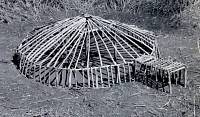
The framework is completed. Next, layers
of grass will be added and then a thick layer of earth.
|
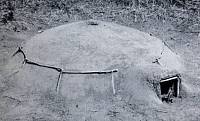
The completed earth lodge. Note human figure
in doorway for scale. The visible wooden framework was added
atop the earth to help keep it in place (idea based on archeological
evidence).
|
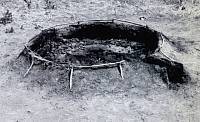
Fire has gutted the earth lodge, causing
the roof to collapse. The walls remain partially intact.
|

Following simulated weathering, the burned
earth lodge was swept out, revealing the charred stumps of
posts. The experimental pattern closely resembled the archeological
pattern seen at the Talking Crow site. Although Hank's house
is much smaller and rectangular instead of round, it shares
many similarities.
|
|